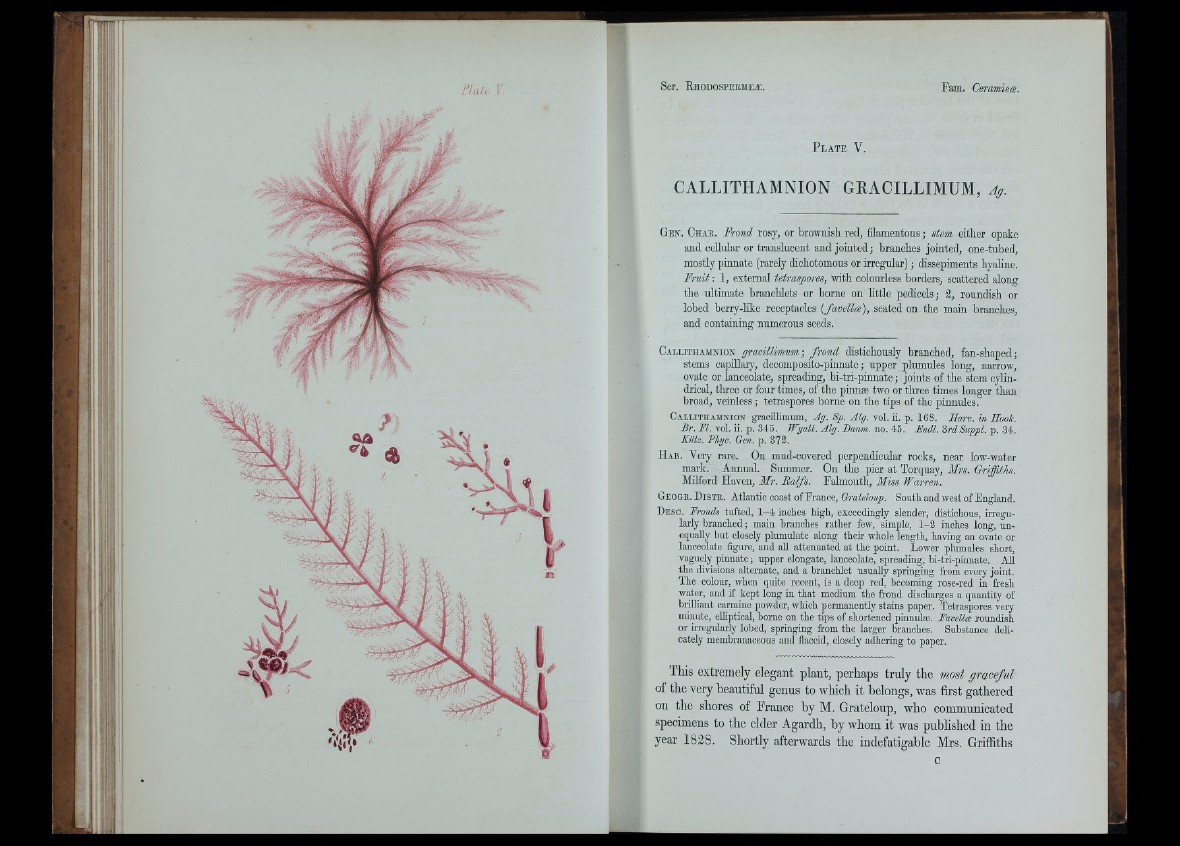
ñau. tí
P la t e V.
CALLITHAMNION GRACILLIMUM, Ag.
Gen. Chak. Frond rosy, or brownish red, filamentous; stem either opake
and ceUnlar or translucent and jointed; branches jointed, one-tubed,
mostly pinnate (rarely dichotomous or irregular); dissepiments hyaline.
F r u it: 1, external tetraspores, with colourless borders, scattered along
the ultimate branchlets or borne on little pedicels; 2, roundish or
lobed berry-like receptacles (favellm), seated on the main branches,
and containing numerous seeds.
C a llith am n io n gracillimum-, fro n d distichonsly branched, fan-shaped;
stems capillary, decomposito-pinnate; upper plumules long, narrow,
ovate or lanceolate, spreading, bi-tri-pinnate; joints of the stem cylindrical,
three or four times, of the pinnae two or three times longer than
broad, veinless; tetraspores borne on the tips of the pinnules.
C a l l i t h a m n i o n gi-acffliraum, Ag. Sp. Alg. vol. ii. p . 1 6 8 . Harv. in Hook.
D r . vol. ii. p . 3 4 5 . Wyatt. Alg. JDanm. tío. i i . JEndl.3riSuppl.-a.3i.
Kiitz. Pliyc. Gen. p . 3 7 2 .
H ab. Very rare. On mud-covered perpendicular rocks, near low-water
mark. Annual. Summer. On the pier at Torquay, Mis. Griffiths.
Müford Haven, JMr. JRalfs. Falmouth, JMJiss Warren.
G e o g k . D is t k . Atlantic coast of France, Grateloup. South and west of England.
D e s c . Eronds tufted, 1 - 4 inches high, exceedingly slender, distichous, irregu-
lai-ly branched; main branches rather few, simple, 1-2 inches long, unequally
but closely plumulate along their whole length, having an ovate or
lanceolate figure, and all attenuated at the point. Lower plumules short,
vaguely pinnate; upper elongate, lanceolate, spreading, bi-tri-pinnate. All
the divisions alternate, and a branchlet usually springing from every joint.
The colour, when quite recent, is a deep red, becoming rose-red in fresh
water, and if kept long in that medium the frond discharges a quantity of
brilliant carmine powder, which permanently stains paper. Tetraspores very
minute, eUiptical, borne on the tips of shortened pínnulas. Favellm roundish
or iiregularly lobed, springing from the larger branches. Substance delicately
membranaceous and fiaccid, closely adhering to paper.
This extremely elegant plant, perhaps truly the most graceful
of the very beautiful genus to which it belongs, was first gathered
on the shores of France by M. Grateloup, who communicated
specimens to the elder Agardh, by whom it was published in the
year 1828. Shortly afterwards the indefatigable Mrs. Griffiths